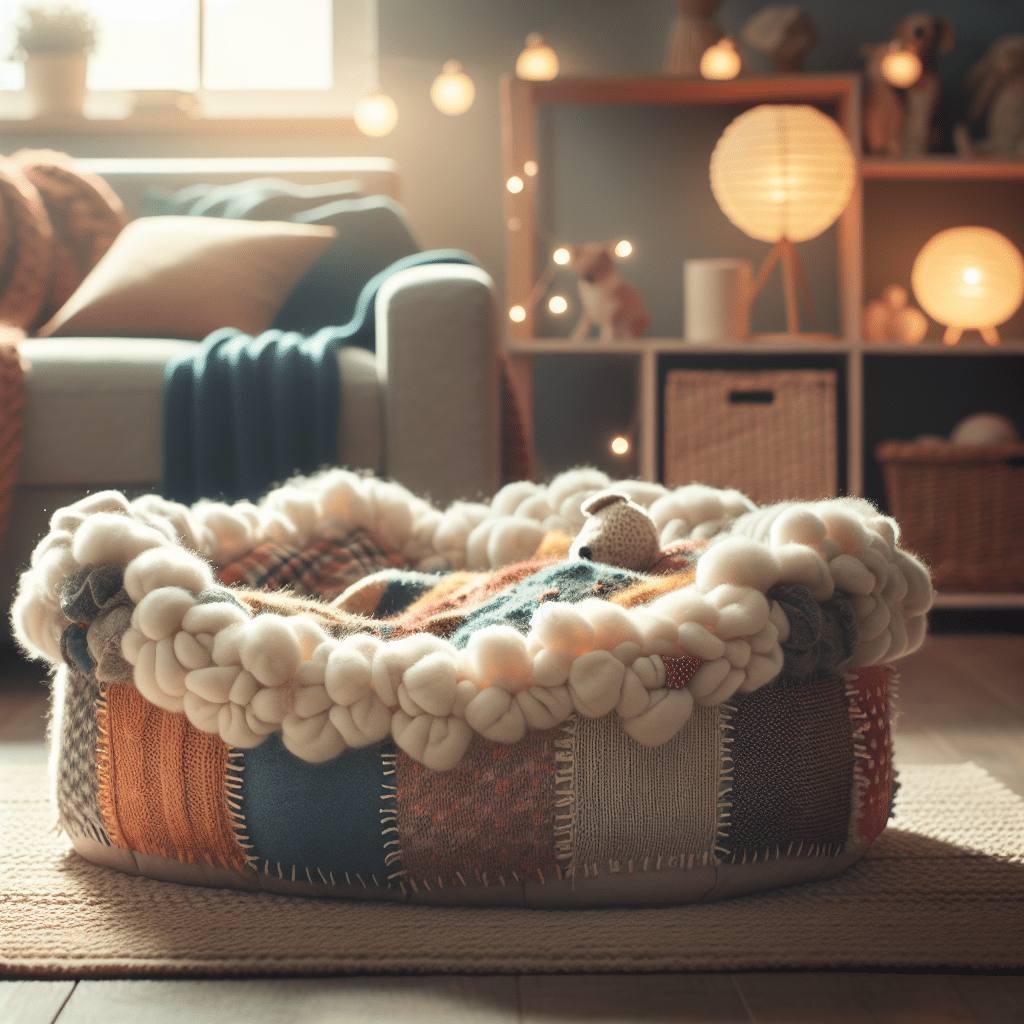Creating a Cozy Dog Bed from Repurposed Blankets
Materials Needed
To create a cozy dog bed from repurposed blankets, gather the following materials:
- Old Blankets: Choose soft, thick blankets for comfort. Fleece, flannel, or even old quilts work well.
- Scissors: For cutting the blankets to the desired size.
- Needle and Thread or Sewing Machine: For sewing the pieces together, depending on your comfort level with sewing.
- Measuring Tape: To ensure the bed is the right size for your dog.
- Fabric Pins or Clips: To hold the material in place while you sew.
- Optional Stuffing: If you want to add extra cushioning, consider repurposing foam, old pillows, or cotton batting.
Choosing the Right Size
Before cutting any blankets, measure your dog to determine the correct size for the bed. A good rule of thumb is to add 12 inches to the length and width of your dog’s body length to create a comfortable space. For example, if your dog is 24 inches long and 18 inches wide when curled up, aim for at least 36 x 30 inches for the bed.
Selecting and Preparing Blankets
Once you have selected your materials, wash them thoroughly to remove any dirt, allergens, or scents that might bother your dog. This is especially important for old blankets, which may have been stored for a while. After washing, check for damages; any holes or fraying should be repaired or avoided altogether.
Designing the Cozy Bed
Decide on the bed design. There are several styles you can create with repurposed blankets:
- Pillow Style: Utilize a single blanket to create a simple pillow bed. Fold it into quarters for extra cushioning and sew the edges together.
- Nest Style: Combine multiple blankets to form a nest-like shape. This bed features raised edges that provide a sense of security for dogs who prefer to curl up.
- Cushion Style: Stitch together a top and bottom layer while adding stuffing in between for added comfort. This can be easily customized to your dog’s size.
Cutting the Blankets
If you’re making a simple pillow bed, cut the blanket down to the desired dimensions. For a nest or cushion style, it’s often beneficial to use multiple layers for additional warmth. Cut each blanket so they fit one over the other seamlessly.
Sewing the Pieces Together
Once the pieces are cut, lay them out in the order you would like to stitch them together. Use fabric pins or clips to secure them. If you are making a simple bed, fold the blankets in half, pin the edges, and sew around three sides, leaving one side open for stuffing or for the final layer. For a more intricate design, like a nest-style bed, stack the blankets in layers and sew around the perimeter, leaving one section open for stuffing.
Adding Custom Touches
Incorporate custom touches to your dog’s bed. You might add decorative patches, your dog’s name, or even an inconspicuous pocket for storing dog accessories. Use contrasting colors or fabrics to make it visually appealing. This not only makes the bed unique but also adds a personal touch.
Stuffing the Bed
If you’ve decided to create a cushion-style bed, fill the opening with stuffing. Use soft materials; foam scraps, old towels, and cotton batting are effective choices. Make sure the stuffing is evenly distributed to avoid lumps. For a washable option, ensure that you can remove the stuffing, perhaps by creating a zippered closure.
Finishing Touches
After you have finished stuffing and sewing the bed, check for any loose threads or uneven sections. Trim those away to ensure your dog’s safety and comfort. You might also consider a light spray of pet-safe fabric refresher to keep the bed smelling fresh.
Washing and Maintenance
One of the benefits of creating a dog bed from repurposed blankets is ease of maintenance. Regularly wash the bed to remove dirt and odors. Depending on your construction, you may be able to remove some sections for cleaning or simply wash the whole bed if it was made with machine-washable materials.
Choosing Fabrics Wisely
Selecting the right fabrics is crucial when creating a dog bed. Soft fabrics such as fleece or cotton tend to be popular choices for their warmth and comfort. Additionally, consider weather-resistant fabrics if your dog often spends time outdoors. While repurposed blankets can be a great starting point, incorporating materials like water-resistant tarp can increase lifespan.
Accessibility and Safety
Ensure the bed is accessible for your dog, regardless of their age or mobility. If you have a senior dog or one with mobility issues, consider creating a bed frame or platform that raises the bed off the ground, making it easier for them to get in and out. Avoid sharp edges and small parts that could be chewed off and swallowed.
Eco-Friendly Benefits
Repurposing blankets not only creates a comfortable space for your dog but also promotes sustainability. By using materials you already have, you contribute to reducing waste and minimizing environmental impact. This eco-friendly approach is a win-win for both you and your furry friend.
Budget-Friendly Approach
Creating a dog bed from repurposed blankets can be a cost-effective solution compared to buying new ones in stores. By utilising old fabrics that you already own, you save money while creating a tailored comfort that meets your dog’s needs precisely.
Engaging the Family
Involve your family members in the crafting process. Allow children to assist in choosing materials or even in sewing parts of the bed under supervision. This can be a lovely activity to bond with your loved ones and for them to learn about sustainable practices.
Conclusion
Creating a cozy dog bed doesn’t have to be complicated or expensive. By repurposing old blankets, you can craft a personalized and comfortable space for your furry friend, ensuring they have a tranquil retreat in your home. With a little creativity and effort, your dog can enjoy a beautifully crafted bed that reflects both functionality and style.
